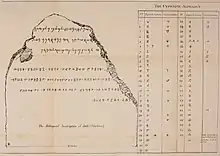Idalion bilingual
The Idalion bilingual is a bilingual Cypriot-Phoenician inscription found in 1869 in Dali, Cyprus.[2] It was the key to the decipherment of the Cypriot syllabary, in the manner of the Rosetta Stone to hieroglyphs.[3] The discovery of the inscription was first announced by Paul Schröder in May 1872.[4] It is dated to 388 BCE. The Phoenician inscription is known as KAI 38 and CIS I 89.
_(cropped).jpg.webp)

It was discovered by Robert Hamilton Lang in his excavations at the Temple of Idalium (modern Dali, Cyprus), whose work there had been inspired by the discovery of the Idalion Tablet in 1850. The stone was found in the centre of the temple, together with the five other Idalion Temple inscriptions. The stone is thought to have been a pedestal for a statue, as there is an apparent dowel hole in the top.[5]
Lang wrote of his discovery:[6]
The most valuable monument uncovered by my excavations is unquestionably the bilingual inscription in Cyprian and Phoenician, engraved on marble; an inscription which, I feel confident, will ultimately prove the means of enabling philologists to decipher the Cyprian alphabet ... The bilingual inscription proves also that, the two alphabets, Phoenician and Cyprian, had a contemporaneous existence.
It is currently in the archives of the British Museum, with identification number 125320.[5] It was exhibited at the Fitzwilliam Museum in Cambridge in 2018.[3]
Inscriptions
Phoenician

The Phoenician inscription is three lines long, written right-to-left.[5][7]
The Phoenician text has been translated as follows:[3]
On day ? of the month ? in year IV of King Milkyaton King of Kition and Idalion: this is the statue which Lord Baalrom son of Abdimilk gave and raised to his Lord Reshep Mikal because he heard his voice: may he bless.
Cypriot
The Cypriot inscription is written in the Greek language. It is four lines long, also written right-to-left.[5] It was used by George Smith to decipher the Cypriot syllabary in 1871, in the manner of the Rosetta Stone to hieroglyphs.[3] It is dated to 388 BCE. Subsequently, Egyptologist Samuel Birch (1872), numismatist Johannes Brandis (1873), philologists Moritz Schmidt, Wilhelm Deecke, Justus Siegismund (1874) and dialectologist H. L. Ahrens (1876) all built on Smith's decipherment of the stone.[8]
The Cypriot-Greek text has been translated as follows:[3]
[In the fourth year] of King Milkyaton, reigning over Kition and Idalion, on the last (day) of the period of five intercalary days, the prince (Baalrom), son of Abdimilk, has dedicated this statuette to Apollo Amyklos, from whom he has obtained the accomplishment of his wish. To good fortune.
Bibliography
- On the Reading of the Cypriote Inscriptions George Smith, 1871
See also
Notes
- "base; votive offering; block". British Museum. Retrieved 9 January 2021.
- Society, American Oriental (1880). Journal of the American Oriental Society. American Oriental Society. pp. 93–.
- CREWS Display: The Idalion Bilingual
- Paul Schröder, 6 May 1872, Über einige Fragmente phönikischer Inschriften aus Cypern, 6. Mai. Sitzung der philosophisch-historischen, Monatsberichte der Königlichen Preussische Akademie des Wissenschaften zu Berlin; Königliche Preussische Akademie der Wissenschaften: [Footnote]: "Diese zuletzt erwähnten Inschriften, sechs an der Zahl (das Fragment einer siebenten besteht nur aus den fünf Buchstaben .....) wurden 1869 von dem damaligen Agenten der ottomanischen Bank, jetzigem englischen Consul zu Larnaka, Hrn. Lang, zu Dali (dem alten Idalion, phön. .....), ungefähr eine Viertelstunde südlich vom Dorfe, zugleich mit einer grofsen Menge von Statuen, Statuetten, Köpfen, Reliefs, Terracotten, griechischen und cypriotischen Inschriften u. s. w. ausgegraben und befinden sich jetzt im britischen Museum."
- British Museum BM 125320
- J. Murray (1878). "NARRATIVE OF EXCAVATIONS IN A TEMPLE AT DALI (IDALIUM) IN CYPRUS, BT R. H. LANG ESQ., WITH OBSERVATIONS ON THE VARIOUS ANTIQUITIES FOUND THEREIN, BY R. S. POOLE, ESQ., KEEPER OF THE COINS AND MEDALS, BRITISH MUSEUM. (Read November 16, 1871.)". Transactions of the Royal Society of Literature of the United Kingdom. Royal Society of Literature (Great Britain): 51.
- Paul Schröder, 6 May 1872, Über einige Fragmente phönikischer Inschriften aus Cypern, 6. Mai. Sitzung der philosophisch-historischen, Monatsberichte der Königlichen Preussische Akademie des Wissenschaften zu Berlin; Königliche Preussische Akademie der Wissenschaften: [Footnote]: "Die Sechste lnschrift endlich ist eine Bilinguis: auf einen nicht ganz vollständig erhaltenen phönikischen Text von drei Zeilen, welcher mit den Worten .........beginnt und mit ...... schliefst, folgt ein vierzeiliger unversehrter Text in sogenannter cypriotischer Schrift von ungefähr 100 Buchstaben. Da diese cypriotische Inschrift aller Wahrscheinlichkeit nach nur die Übersetzung der darüber stehenden phönikischen Inschrift ist, so ist diese Bilinguis für die Entzifferung der sog. cypriotischen Schrift von grofser Wichtigkeit."
- Cypro-Syllabic script, Scuola Normale Superiore di Pisa